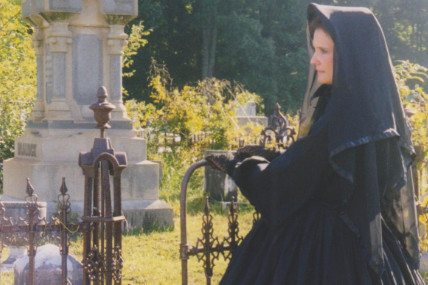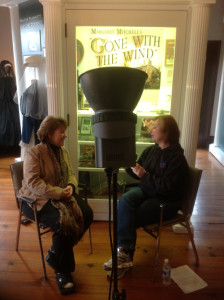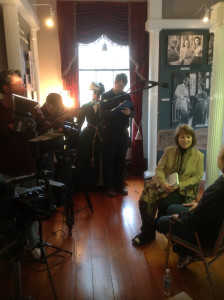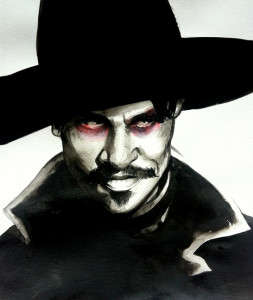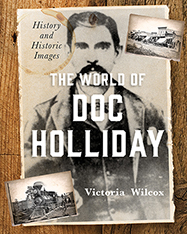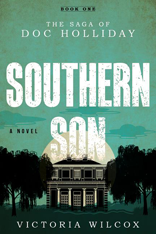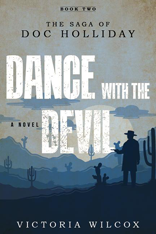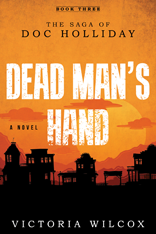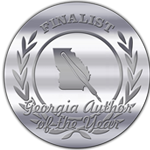I love ghost stories, the spookier the better – like spectral figures that stalk the grounds of ancient estates, faces that appear in old windows and mirrors, doors that lock themselves when no one is in a room, things that go bump in the night…
Doc Holliday grew up in a world of such things, in a land where Indian legends still echoed in strange names like Etowah and Ocmulgee, where Irish ancestors left tales of wood sprites and banshees, where black slaves told stories of haints and bogymen and “boo hags” that hid in the dark piney woods. When a beloved family member passed, even good Christian folk covered all the reflective glass in the house lest the dearly departed should peer back at them from beyond the veil. So one would expect that the Holliday’s house, built in the 1850’s and a place where generations of family members lived and loved and died, should be filled to overflowing with spirits. How could such a classic Southern mansion not have a few classically Southern ghosts to go with it?
So one of my first questions, on one of my first visits to the Holliday House, was whether or not it was haunted. Or, as I put it to the nice girl who worked nights at the answering service that had an office there, back when the house was still an unrestored old home with an interesting past and an uncertain future: “Have you seen any ghosts?”
The girl shrugged as though the question wasn’t really worth her time, then told me that the only thing that worried her was trespassers, so she kept both the entrance door and the door to her office locked tight when she was alone. Except that the entrance door was really an antique double door that didn’t lock tight and sometimes blew back open in the wind. But no, she had never heard or seen anything out of the ordinary, other than mice and squirrels and the stray bird flying down from the open-eaved attic, and she was there all night, every night. Ah, well!
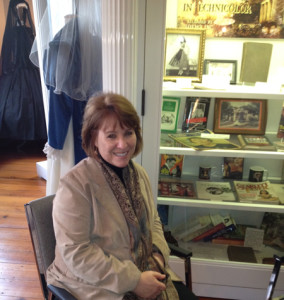
In the unhaunted Gone With the Wind room at the Holliday House, ready to shoot a TV pilot about Georgia Ghosts.
So I wasn’t expecting anything spooky when I began my work as founding director of the Holliday-Dorsey-Fife House Museum in the soon-to-be restored house. Oh, we still had rodents and birds and doors that didn’t close tight and blew themselves open in the wind, lots of creaks and moans from a house that was showing its age at 150 years old and counting, and lots of dark and stormy nights before the electrical wiring was replaced and the lights came on again. In fact, we played up the darkness and the creaks and groans at our annual Halloween-week “Great Georgia Ghosts,” when we invited in local storytellers to sit in the candlelit rooms and scare the bejeebies out of our guests in exchange for their donations to the restoration. It was a great money maker – especially the night when a real storm blew through, and the stories were accompanied by lightning and thunder and shrieking visitors. But still, no real ghosts.
But then a writer of some repute, working on a new book of regional ghost stories, called up and wanted to chat. She’d heard of the Holliday House and its relationship to the legendary Western character Doc Holliday and Gone With the Wind and thought it would make for a terrific chapter, if I’d like to share our ghost stories with her. And surely, such a historic place would have some terrific ghost stories! I was sorry to have to tell her the sad truth that this old house was remarkably unhaunted, though we could certainly use the notoriety a spook or two would bring, and she was equally sorry to hear the news.
“But there must be something!” she said. So I shared with her a story we told on our tours, though it wasn’t really a ghost story – more of a visitation, and nothing spooky at all. As I was there when it happened, I could tell the facts as I knew them:
Although the house now has three names, it was originally just the Holliday House Museum, named after the family that first owned the place. But as word got around that this historic Fayetteville home was being restored, other families with connections to the house came forward to share their own history. First was the Fife family, the most recently residing in Fayetteville, and the house became the Holliday-Fife House. Then Dorsey descendent Beth McCombs Kissel contacted me, and told us how Colonel Solomon Dawson Dorsey had purchased the house after the Civil War, when the Hollidays moved to Atlanta, and how his grandson Hugh Dorsey, who later became Governor of Georgia, was born there. The Dorseys had their own wonderful history to share, so the house was renamed again, and became the Holliday-Dorsey-Fife House – and we were glad there hadn’t been more years and more family names to add to the list!
Beth lived north of Atlanta and was eager to see her family’s former home, so I invited her down and we took a long tour of the house, looking into every closet (the house was filled with them, very unusual in a home of this period as a building was taxed on the number of rooms and a closet was considered a taxable space) and imagining the house in the late 1800s and early 1900s when her family owned the place. There wasn’t much else to do but imagine, as the unrestored house was still mostly empty, with just a few representative items in each room. While we explored, her husband, a police detective by trade, took his own tour and shot lots of photos. He didn’t have his wife’s interest in old houses or in the many cemeteries she liked to visit while doing her family research – an enormous amount of research that had assembled something like 5,000 names going back centuries. He found these tours a bit boring, and amused himself with his photography.
His last shots were taken at the end of our tour, after we had locked up the empty house and were standing outside on the small lawn that fronts busy Georgia Highway 54. And it was one of those shots that gives the Holliday House its only recorded hint of a haunting. When the film was developed, there seemed to be a smudge on one of the pictures, so the photo was enlarged – and showed what looked like a face looking back out of one of the upstairs windows. This, of course, in a house that we had just left empty and locked. To Beth, the Dorsey descendent, the smudge looked like a face that bore a striking resemblance to one of her Dorsey ancestors. To her husband, who had grudgingly gone along with her family history work until then, it was a turning point – maybe her work wasn’t so silly, after all, maybe these spirits somehow knew that she was reconstructing the family, and approved. Especially since that face had never been seen before at the house and has never been seen again since, even though Beth joined the Board of Directors of the Holliday House Association and spent many hours there helping with the museum project. If it were indeed a visitation, it was a one-time visit by a spirit who had a message to deliver, and delivered it.
So that was the story I told to the folklorist writing the new ghost story book. She listened, thanked me for my time, and said goodbye. I got the feeling that she wasn’t too impressed by our unspooky family spirit. And that was the end of it, as far as I knew – until a year or so later, when I happened into a small bookstore on a visit to Savannah, and found the writer’s new ghost story book on the shelf. Maybe she’d collected better stories at other sites, I thought, and bought the book thinking it might have something we could use for our next “Great Georgia Ghosts” fundraiser storytelling night. What a surprise to find a chapter on the Holliday House, with myself quoted telling the story of Doc Holliday and his relation to the place – and with a new story I had never heard (and hadn’t told) about how the ghost of Doc Holliday walked the grounds of the Holliday House, being seen on dark nights wearing a long duster and carrying his six-shooter and putting a scare into the local police.
Of course, I called the writer up as soon as I returned home, and asked where she’d gotten this ridiculous story – Doc Holliday had never been known to haunt the Holliday House, nor had anyone else. And what self-respecting ghost would wander the grounds of a building so close to a busy highway with trucks lumbering by? She laughed and said she’d made it up, as “everyone knows these stories are all just folklore, anyway.” What was the harm?
The harm was that now the Holliday House had a ghost, at least as far as her readers were concerned, and we started to have visitations from very real people who wanted to see our ghost. One poor couple drove all the way from California to Georgia hoping to see Doc Holliday! And then, as the initial flurry of interest died down, the story rose from the dead on the Internet, and now can be found everywhere, making the Holliday House one of Georgia’s most famous haunted houses – except that it’s not. One paranormal investigator even claims to have visited and recorded a man’s gruff bass voice saying, “My lungs hurt!” as though the consumptive ghost of the Holliday House wanted to share his misery. The investigator likely didn’t know that Doc was only a child when his uncle’s family lived there, and that they had moved to another big house in Atlanta before he was a grown man, and that his consumption killed him years later in the far-away mountains of Colorado. I suppose people hear what they want to hear – and the truth would spoil the story. But the lie steals from the best story, the one where the detective decided that his wife’s family history work was worthwhile.
There is no Doc Holliday wandering the grounds of the Holliday House, sad to say, nor any other ghost as far as we know. The place was “haunted” by a writer who wanted to sell books, and didn’t mind making things up. And how do you get rid of a ghost that isn’t there?
Interesting Links
Tours of Fayetteville
Ghost Girlz
Click the book cover below for more info or to order.
